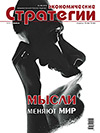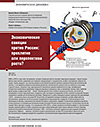Economic Sanctions Against Russia: Damnation of Decrease or Springboard for Free Flight?
2000s and 2010s are usually called “transition period”. On the one hand, during this time we observe the strengthening of the international cooperation actively being started with reforms under the rules of the G20 as the response to the intensification of global financial system’s development internal contradictions and the emergence of global economic crisis. On the other hand, these years are characterized by an increased level of conflicts manifested in the vigorous and collective application of sanctions and the declaration of trade wars. The subject of the article is especially relevant for Russia having been already sanctioned for 5 years. The purpose of this research is to analyze the impact of sanctions on the target economy. The paper provides a brief description of the existing sanctions against Russia since 2014. The second part of research is devoted to the identification of conditions for the effectiveness of economic sanctions. The third section includes the analysis of the negative sanction effect’s reasons and evidence. Finally we provide arguments in favor of real and potential opportunities for Russia to obtain economic benefits from the sanctions. In 2014–2016 we observed the negative effect of economic sanctions expressed in the form of losses and lost profits and caused as logical consequence of Russian economy’s development features. There are preconditions for creating a positive effect from sanctions — an impulse that can bring Russian economic system to a qualitatively new stage of growth. These positive trends need to be developed and sustained by domestic government support.
References:
- Glaz’ev S.Yu. Ryvok v budushchee. Rossiya v novykh tekhnologicheskom i mirokhozyaistvennom ukladakh [Burst into the Future. Russia in the New Technological and World Economic Structures]. Moscow, Knizhnyi mir, 2018.
- Prins N. Collusion. How Central Bankers Rigged the World. New York, Nation Books, 2018.
- Zvonova E.A. Sokhranenie mezhdunarodnoi konkurentosposobnosti natsional’noi ekonomiki strany — ob”ekta ekonomicheskikh sanktsii (opyt Irana) [Sustaining the International Competitiveness of the National Economy of a Country Under Economic Sanctions (Iran Case Study)]. Ekonomika. Nalogi. Pravo, 2017, no 2, pp. 30–37.
- Zvonova E.A. Evolyutsiya ekonomicheskoi politiki Respubliki Kuba v usloviyakh mezhdunarodnykh sanktsii [The Evolution of Economic Policy of the Republic of Cuba Under International Sanctions]. Natsional’nye interesy: prioritety i bezopasnost’, 2017, tom 13, vypusk 7, pp. 1378–1392.
- Dmitrieva N.I. Ekonomicheskie sanktsii kak instrument politicheskogo davleniya [Economic Sanctions As a Political Pressure Instrument]. Gosudarstvennoe upravlenie. Elektronnyi vestnik, 2015, no 52, pp. 120–143.
- Ershov M.V. Kakaya ekonomicheskaya politika nuzhna Rossii v usloviyakh sanktsii? [What Economic Policy Does Russia Need under Sanctions?]. Voprosy ekonomiki, 2014, no 12, pp. 37–53.
- Sukharev O.S. Ekonomicheskie sanktsii: problema otsenki ushcherba [Economic Sanctions: Issue of Loss Assessment]. Ekonomika i predprinimatel’stvo, chast’ 4, 2017, no 8, pp. 80–87.
- Russian Federation: 2015 article IV consultation. IMF Staff Country Report no 15/211.2015.
- Glaz’ev S.Yu., Arkhipova V.V. Otsenka vliyaniya sanktsii i drugikh krizisnykh faktorov na sostoyanie rossiiskoi ekonomiki [Sanctions and Other Crisis Factors Impact Assessment on the Russian Economy’s State]. Rossiiskii ekonomicheskii zhurnal, 2018, no 1, pp. 3–29.
- Gurvich E., Prilepskii I. Vliyanie finansovykh sanktsii na rossiiskuyu ekonomiku [The Impact of Financial Sanctions on the Russian Economy]. Voprosy ekonomiki, 2016, no 1, pp. 5–35.
- Shirov A.A., Yantovskii A.A., Potapenko V.V. Otsenka potentsial’nogo vliyaniya sanktsii na ekonomicheskoe sostoyanie Rossii i ES [Estimation of Potential Impact of Sanctions on the Economy of Russia and the EU]. Problemy prognozirovaniya, 2015, no 4, p. 3–16.
- Russell М. Sanctions over Ukraine. Impact on Russia. European Parliamentary Research Service, 2018, available at: www.europarl.europa.eu/RegData/etudes/BRIE/2018/614665/EPRS_BRI%282018%29614665_EN.pdf.
- Ispolnenie federal’nogo byudzheta i byudzhetov byudzhetnoi sistemy Rossiiskoi Federatsii za 2016 god [Execution of the Federal Budget and Budgets of the Budgetary System of the Russian Federation for 2016]. Moscow, Ministerstvo finansov Rossiiskoi Federatsii, 2017, available at: https://www.minfin.ru/ru/document/?id_4=118204.
- Modest Growth Ahead. 39 Russia Economic Report, World Bank Group, 2018, available at: http://documents.worldbank.org/curated/en/221891529097400830/pdf/127254-WP-PUBLIC-ADD-SERIES-JunefinalRussiaEconomicReportENG.pdf.
- Polterovich V.M. Strategii institutsional’nykh reform. Kitai i Rossiya [Strategies of Institutional Reforms. China and Russia]. Ekonomika i matematicheskie metody, 2006, tom 42, no 2, pp. 3–16.
- Arkhipova V.V. Global’nye finansovye reformy 2008–2016 godov v kontekste razvitiya rossiiskoi ekonomiki: ugrozy i vyzovy institutsional’nogo eksperimenta [Global Financial Reforms of 2008–2016 in the Context of Russian Economic Development: Threats and Challenges of Institutional Experiment]. Gosudarstvennoe upravlenie. Elektronnyi vestnik, 2017, no 60, pp. 34–48.
- The Importance of Local Capital Markets for Financing Development, World Bank Group, IFC, 2017, available at: https://www.ifc.org/wps/wcm/connect/7481a4fb-4ec2-47be-9e8f-675e63296575/EM+compass+Note+28+Capital+Markets+FINAL.pdf?MOD=AJPERES.
- Peer Review of Russia. Review Report. Financial Stability board, 2015, available at: www.fsb.org/wp-content/uploads/Russia-peer-review-report-final.pdf.
- Statistika vneshnego sektora [External Sector Statistics]. Tsentral’nyi bank Rossiiskoi Federatsii, 2018, available at: www.cbr.ru/statistics/?PrtId=svs.
- Effective exchange rate indices. Bank for International Settlements, 2018, available at: https://www.bis.org/statistics/eer.htm?m=6%7C381%7C676.
- Statistics on payment, clearing and settlement systems in the CPMI countries. Figures for 2016. Bank for International Settlements, 2017, available at: https://www.bis.org/cpmi/publ/d172.htm.
- Statistics on payment, clearing and settlement systems in the CPSS countries. Figures for 2011. Bank for International Settlements, 2013, January, available at: https://www.bis.org/cpmi/publ/d107.pdf.
- General trade performance. Russian Federation. International Trade Centre, available at: http://www.intracen.org/layouts/CountryTemplate.aspx?pageid=47244645034&id=47244652485.
- Otsenka tekushchego sostoyaniya i perspektivy rossiisko-kitaiskogo ekonomicheskogo sotrudnichestva: obmen mneniyami i obshchaya pozitsiya storon [Assessing the Current State and Prospects of Russian-Chinese Economic Cooperation: Exchange of Views and Joint Position of the Parties]. Ekonomicheskie strategii, 2018, no 6 (156), pp. 22–31.



